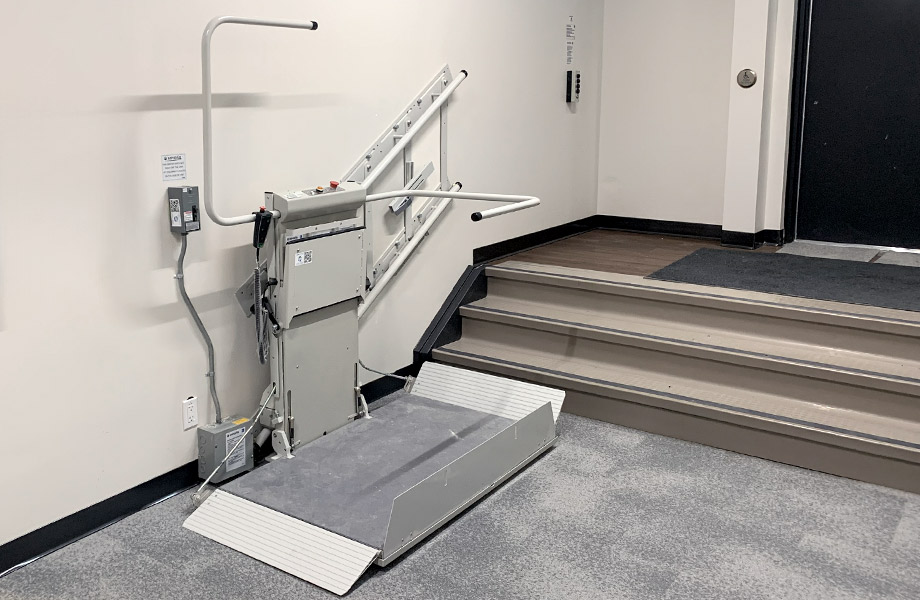Toll Free: 1.888.333.5023
Menu
What is a platform lift? Is there funding available for wheelchair lifts?
Find answers to these and other frequently asked questions about wheelchair lifts for your home, from how they work to how far they can travel, and more.
Can’t find the answer you’re looking for? Contact us to get connected with your local Savaria Home Access expert.

A wheelchair lift transports a person in a wheelchair—and sometimes an attendant, too—from one level to another. For home use, they can be installed indoors or outdoors depending on the model. There are two main types of wheelchair lifts: vertical platform lifts and inclined platform lifts. Both require the use of constant pressure controls to move the lift so the platform stops moving when the user releases the button.
Vertical platform lifts (VPLs) move a passenger in a wheelchair straight up and down. There are both indoor and outdoor models available, and units can range from very “Plain Jane” accessibility to the luxury glass and stainless steel models more commonly found in high-end commercial buildings.
Inclined platform lifts (IPLs) unfold to allow a passenger in a wheelchair to travel up a flight of stairs. For that reason, some people also call this type of lift a ‘wheelchair stairlift’ or ‘wheelchair stair chair.’ With these lifts the platform folds up against the wall for easy access to the stairs when the unit is not in use. Straight inclined platform lifts are designed for a single set of straight-run stairs, whereas curved IPLs can accommodate winding staircases, or ones with turns and intermediate landings. Curved units are also typically used if out-of-the-way parking of the platform is required.
Inclined platform lifts do not usually require a shaftway or machine room. They are a great solution for spaces that are too narrow to accommodate a vertical platform lift or elevator.
There are a lot of variables when it comes to wheelchair lift costs, such as model, location, distance of travel and the specifics of your home.
For a two-stop unenclosed vertical platform lift, you should expect to pay more for more greater travel distance, complex projects, luxury customizations, and optional features.
For a straight-run inclined platform lift, a lot depends on the size and configuration. Curved inclined platform lifts are typically more expensive since they feature a rail that’s custom-fabricated to the exact measurements of the staircase.
Your local Savaria Home Access expert is the best resource for accurate pricing in your area. Contact yours to book a free assessment and get a no-obligations quote.
If you use a walker, rollator or wheelchair, a wheelchair lift is often more practical than a stairlift that does not allow you to take your mobility device along for the ride! You can enter and exit a wheelchair lift while staying seated in your wheelchair or using another mobility device—and still have your chair or device with you and ready to use when you reach the other level! You may still be able to use a stairlift instead if you are able to safely transfer to and from the stair chair, and/or do not need to use your mobility device at all times. It’s always a good idea to talk to your healthcare professional about your unique needs before making a purchase.
Depending on the model, you may be able to install a vertical platform lift or inclined platform lift outdoors. Many models are designed for varying weather conditions, depending on the severity of things like temperature and wind speed. Note that outdoor lifts usually require additional maintenance.
Many wheelchair lift installers will buy back used equipment that is in good working condition. Get in touch with your nearest Savaria Home Access expert to learn more.
Wheelchair lifts may be covered as Durable Medical Equipment (DME) under Medicare Part B (Medical Insurance) if it is deemed necessary by a doctor for use in your home. Refer to Medicare for more information.
You may be able to get funding through your private insurance provider or local, state, and national organizations. Contact your local Savaria Home Access expert to learn about funding options.
You will need to meet the following space requirements to install a wheelchair platform lift.
Vertical Platform Lifts – Porch Lift
Minimum footprint: 54″x74″ (for a platform that is 36″x48″)
Vertical Platform Lifts – Wheelchair Lift Inside Hoistway
Hoistway minimum size: 54″x54″ (for a 36″x48″ platform)
Inclined Platform Lift
Minimum width of stairs: 38″
Bottom landing space: 10 feet
Your local installer is qualified to determine the best fit for your space requirements. Get in touch with a Savaria Home Access expert today.
Vertical platform wheelchair lifts can typically travel from 8 inches to 23 feet, depending on the model and applicable local code.
Typically, vertical platform wheelchair lifts are limited to a 750 lb capacity. Inclined platform lifts have a lower average capacity of 550-660 lb. This will vary depending on the model and local code requirements. The weight of the user as well as the mobility device must be considered when purchasing a wheelchair lift.
Wheelchair lifts are a better home access option than ramps. Since ramps require a large amount of space, it is difficult to meet code requirements. Vertical and inclined platform wheelchair lifts can both accommodate limited space and are safe options.
Unlike an elevator, a vertical platform lift relies on constant pressure controls, meaning the user must continuously push down a button for the lift to move.
There are many technical differences between vertical platform lifts and home elevators. Contact your nearest Savaria Home Access expert for more information.
Didn’t find the answer you were looking for? Complete the form to get in touch.

We’re all about better mobility for life. As a global leader in accessibility, we make products to help people maintain their personal mobility and independence. Your local Savaria Home Access expert would be delighted to conduct a free assessment to help you select the best products for your needs.
© Copyright 2024 Savaria. All rights reserved.
Privacy Policy | Cookie Policy
QUICK LINKS
GET IN TOUCH
Toll Free:
1.888.333.5023
homeaccess@savaria.com
Outside North America:
1.905.799.5519
10888 Metro Court
St. Louis MO 63043 USA